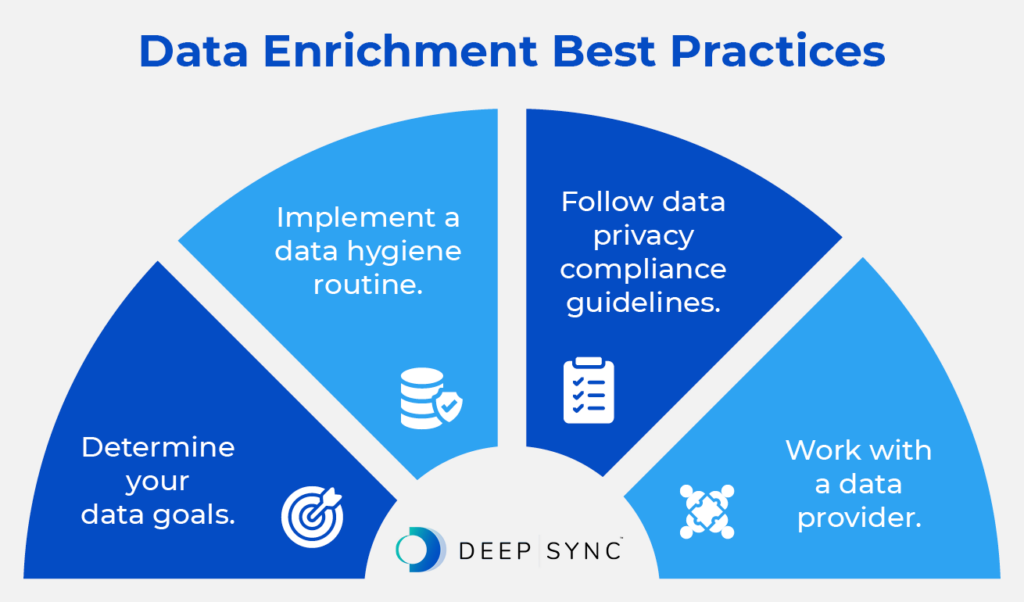Data is the key to reaching prospects, turning them into customers, and retaining them long-term. It allows businesses to make well-informed marketing decisions based on facts about their distinct audiences rather than generalized guesses.
In particular, first-party data (also referred to as 1pd or 1p data) collected through customer interactions can reveal powerful insights about your audience. In fact, 92% of marketers believe this data is critical to business growth.
However, most companies don’t have enough first-party data to exclusively rely on it for their marketing efforts. In other cases, their data is outdated, inaccurate, or incomplete.
That’s where data enrichment comes in. Whether you’re new to the world of customer data or have been leveraging audience insights for decades, we’ll dive deep into data enrichment and provide actionable tips to improve your data strategy for better results.
This guide will provide you with an introduction to data enrichment and walk you through the benefits of leveraging it:
- What Is Data Enrichment?
- What Are the Benefits of Data Enrichment?
- Data Enrichment Best Practices
- Data Enrichment Tools

What Is Data Enrichment?
Data enrichment (also known as customer data enrichment or marketing data enrichment) is the process of supplementing your first-party data with third-party data to confirm you have the most accurate, reliable, and comprehensive database possible.
Unlike first-party data, third-party data comes from an external provider. It provides additional information about your customers, allowing you to expand your reach and improve your targeting.
The third-party data your company can obtain from data enrichment includes:
- Demographics, such as age and gender
- Contact information
- Education
- Marital status
- Home ownership and property data
- Presence of children in the home
- Income
- Net worth
- Lifestyle information, such as which magazines customers subscribe to, where they shop, and which charitable causes they donate to
By improving your first-party data with context pulled from external sources, your company can transform its existing first-party data into actionable marketing insights.
Data Enrichment vs. Data Cleansing
Data enrichment involves adding information to your constituent relationship management platform (CRM) to strengthen your understanding of your customers and help you reach them more effectively. On the other hand, data cleansing requires removing outdated, incomplete, duplicate, or incorrect data.
Both procedures are part of the overarching data hygiene process to keep your database clean and error-free. However, they play different roles in achieving this objective.
Data cleansing typically occurs after you conduct a database audit. At this point, you’ve identified problem areas in your database. Data cleansing allows you to rectify these issues by:
- Removing duplicated data
- Correcting inaccurate entries
- Suppressing unuseful information
After cleansing your database, you’ll better understand any lingering information gaps, allowing you to make well-informed decisions about data enrichment. For example, suppose you find that after cleansing your customer phone numbers, you only have accurate contact information for 30% of your customer base. In that case, you may decide to conduct a phone number append.
Additionally, data cleansing enhances the value of data enrichment. By adding new information to an organized, accurate database, the third-party data you append will be more useful than if you had added it to a CRM riddled with errors and extraneous information.
For instance, if you enrich your database with income and net worth information to find customers suitable for an upcoming luxury product launch before cleansing your database, you may obtain data on former or deceased customers, leading you to waste outreach resources on unviable prospects.
While data enrichment should occur as needed, data cleansing should be a regular part of your data hygiene routine. Cleanse your database every six months or so to pinpoint major issues, solve them, and identify any areas that could benefit from data enrichment.
What Are the Benefits of Data Enrichment?
As part of the overall data hygiene process—which involves various methods of data cleansing and enhancement—data enrichment gives companies a deeper understanding of their current customers’ behaviors, needs, and wants.
This wealth of valuable customer information allows businesses to access the following benefits:

- Enhanced targeting. Marketing data enrichment allows you to expand your customer profiles with attributes like age, marital status, geographic data, and income level. With a better understanding of your customers and their needs, you can target them with more relevant information.
- Effective segmentation. With detailed knowledge of your target audience, you can develop customer segments that personalize your communications. For example, a consumer packaged goods (CPG) company may group customers by geographic location and send customers information on where they can purchase a certain product in their area.
- Cost-savings. When you create more targeted, personalized marketing campaigns, you save resources by only focusing on the customers or segments who are likely to respond to your message. In fact, poor data quality costs businesses an average of $12.9 million per year, demonstrating the immense impact proper data hygiene and enrichment could have on your bottom line.
- Improved customer experience. Customer data enrichment doesn’t just help your marketing team. Better personalization creates messages that actually resonate with customers and their needs, pointing them to relevant products and services and giving them a better experience with your business.
- Meaningful customer relationships. Successfully catering to your customers’ needs allows you to build lasting relationships with them. When customers receive an individualized experience with your company, they’re more likely to continue supporting your business.
Ultimately, data enrichment bridges the gap between what your customers need and what your business can provide them. With better alignment between your customer preferences and communications, both customers and your company have a better experience, leading to higher customer satisfaction and profitability.
What Are Some Data Enrichment Best Practices?
If you’re familiar with data hygiene, you know that it’s an ongoing process. Data enrichment is no different. With data decaying at a rate of 30% each year, your database can quickly become outdated and inaccurate.
This statistic illustrates why you need to keep up with data enrichment and ensure you’re taking a methodical approach with the following best practices:

- Determine your data goals. Identify what goals you seek to achieve through data enrichment, including what data will meet your needs. For example, let’s say you’ve previously focused on print marketing but now want to expand your efforts to digital channels. You can append contact information like email addresses, Mobile Ad IDs (MAIDs), IP addresses, and social media handles to reach your audience online.
- Implement a data hygiene routine. When you create a data hygiene and maintenance routine, you can ensure your database stays in optimal condition. Start by conducting regular audits of your database to identify any areas for improvement. Then, you’ll have a better idea of what data to focus on for cleaning and enrichment. You can also develop procedures for data entry standardization, error resolution, and dirty data prevention to ensure your team is on the same page about database management.
- Follow data privacy compliance guidelines. Obtain datasets from sources that collect data legally and follow all applicable privacy and compliance guidelines. That way, you can protect your customers’ privacy and your company’s reputation.
- Work with a data provider. Partner with a trusted and verified provider like Deep Sync to ensure the external data sources you’re using for data enrichment are accurate and reputable. Additionally, a data provider has the expertise to assist you with other data solutions, such as data quality reports, customer profiling and analytics, and identity resolution.
When you invest in data enrichment best practices, it’ll save you time and resources in the long run by preventing the need for large data overhauls. Instead, a carefully planned approach to data enrichment, with the help of experts, will keep your company’s data accurate, reliable, and actionable.

What Marketing Data Enrichment Solutions Are Available to My Organization?
Now that you know the ins and outs of data enrichment, it’s time to put what you’ve learned into action with the right data enrichment solutions.
Preparing for and executing the data enrichment process can be time-consuming and ineffective when done manually. The following tools and services can help facilitate data enrichment so you can see results as soon as possible.
Customer Relationship Management Platform (CRM)
Every strong data-driven strategy starts with a CRM, like HubSpot or Salesforce. A CRM houses all of your customer data in one place so you can use it to power your marketing efforts and build lasting customer relationships.
Typically, businesses will store the following information in their CRMs:
- Contact information
- Communication history
- Purchasing behavior
- Customer preferences
In addition to storing this vital data, your CRM may also offer features like marketing automation, sales pipeline management tools, reporting and analytics, and integration with other tools in your tech stack.
Customer Data Platform (CDP)
While a CRM relies on manual customer data entry, a CDP gathers information from a variety of sources and transforms this data into customer profiles. For example, a CDP may extract and organize data from:
- Website interactions
- Mobile apps
- Email campaigns
- Social media
- Offline interactions
Then, your CDP will use this real-time data to build robust customer profiles. By unifying a variety of customer data, they help your team avoid data silos and get a fuller picture of what customer information you have before you dive into data enrichment.
If you’re looking for a more flexible CDP solution, you may invest in a composable CDP like GrowthLoop. This type of CDP works directly with your existing data warehouse to streamline data processing.
Native Enrichment Apps in Cloud Environments
With the help of cloud technology, you can store and manage large amounts of customer data that stem from different sources. Some of these cloud environments even offer applications built directly into their ecosystems that allow you to enrich your customer data stored within the platform.
Snowflake

Snowflake is a cloud data platform that helps businesses like Pfizer, Capital One, and Comcast unify and manage their data at scale. It allows companies to reduce their database costs and improve their efficiency by providing a variety of data applications and tools in one place.
Through the Snowflake Marketplace, you can access Deep Sync’s Customer Data Enrichment app, through which you can enrich your marketing data with information like geographic attributes, demographics, financial data, homeownership information, and customer hobbies and interests.
Databricks

Databricks is a “data intelligence platform” that uses artificial intelligence (AI) to help you make the most of your customer data. In addition to storing your data in the cloud, Databricks empowers your team to create generative AI models, implement real-time analytics, unify your data governance, and more.
The Databricks Marketplace offers a variety of native applications, including Deep Sync’s Customer Data Enrichment app that allows you to learn more about your customers and apply that information to your future communications and marketing strategies.
Data Enrichment Services
If you’re looking for more hands-on data enrichment services, explore these providers that will work with you to transform your customer data.
Deep Sync

No matter your industry or data goals, Deep Sync is dedicated to helping your business gain meaningful customer insights through our marketing data enrichment services. The third-party data assets we offer fall under three main categories:
- Contact data attributes. Whether you’re looking for missing or correct names, addresses, phone numbers, or email addresses, we have you covered. We also offer reverse phone and email appends so you can learn more about your customers using only their phone numbers or email addresses.
- Demographic and lifestyle data attributes. Explore your customers’ demographic information to target them more effectively. Through our customer data enrichment solutions, you can append data related to age, gender, education, income range, marital status, presence of children, occupation, hobbies, interests, and more.
- Geocoding. Geocoding allows you to target local or regional audiences by appending customer latitude and longitude coordinates. With Deep Sync, you can apply geocodes at the rooftop ZIP + 4®, carrier route, or ZIP Code™ level.
With Deep Sync data, you can power cross-channel marketing initiatives, identify cross-sell and upsell opportunities, develop targeted customer segments, and personalize your communications.

AlumniFinder

Specializing in nonprofit data enrichment, AlumniFinder helps nonprofits, higher education institutions, and healthcare organizations learn more about their supporters. With their data append services, mission-based organizations can improve the supporter experience they offer and raise more for their causes by personalizing their outreach.
When you work with AlumniFinder, you can enrich your database with information like:
- Address updates
- Name changes
- Phone numbers
- Email addresses
- Dates of birth
- Identification of deceased individuals
- Wealth and philanthropic information
- Employment details
- Social media handles
AlumniFinder customers can run targeted marketing campaigns, tailor their ask amounts based on giving capacity, identify matching gift opportunities, and so much more.
Supercharge Your Customer Data Enrichment Efforts with Deep Sync
Data enrichment can transform your customer database and allow you to further personalize your marketing communications. As a result, you’ll provide a more engaging customer experience and develop lasting relationships with your customer base.
If you’re ready to kick off the data enrichment process, our team is happy to assist you. At Deep Sync, we have the data expertise, solutions, and industry-leading datasets you need to inform your campaigns.
To learn more about how your business can optimize its data, check out the following resources:
- First-Party Data: A Guide to Leveraging Customer Insights. Data enrichment involves supplementing your database to amplify the impact of your first-party data. In this guide, you’ll dive deep into the ins and outs of first-party data and how your company can leverage it.
- Using Data to Improve Direct Mail ROI. While data enrichment enhances your existing data, high-quality first-party data can also help you improve your direct mail ROI. Learn how marketers and advertisers can take advantage of decreased mail volume and mitigate the effects of rising postal prices with high-quality data.
- Boost Your First-Party Match Rates. Enhanced onboarding works by ingesting your customer data, enhancing it with online and offline identifiers, and delivering this file to Meta or TikTok as a custom audience. This allows you to improve your social onboarding results and reach more of your current customers on their favorite channels.














0 Comments